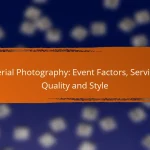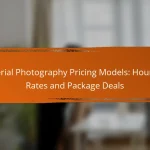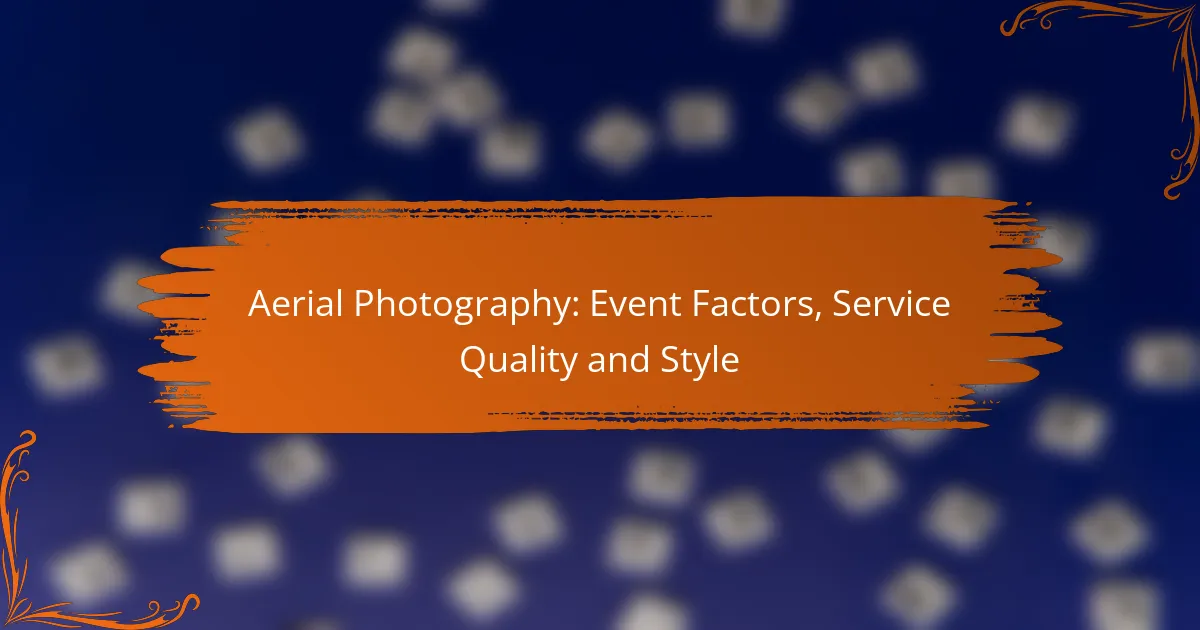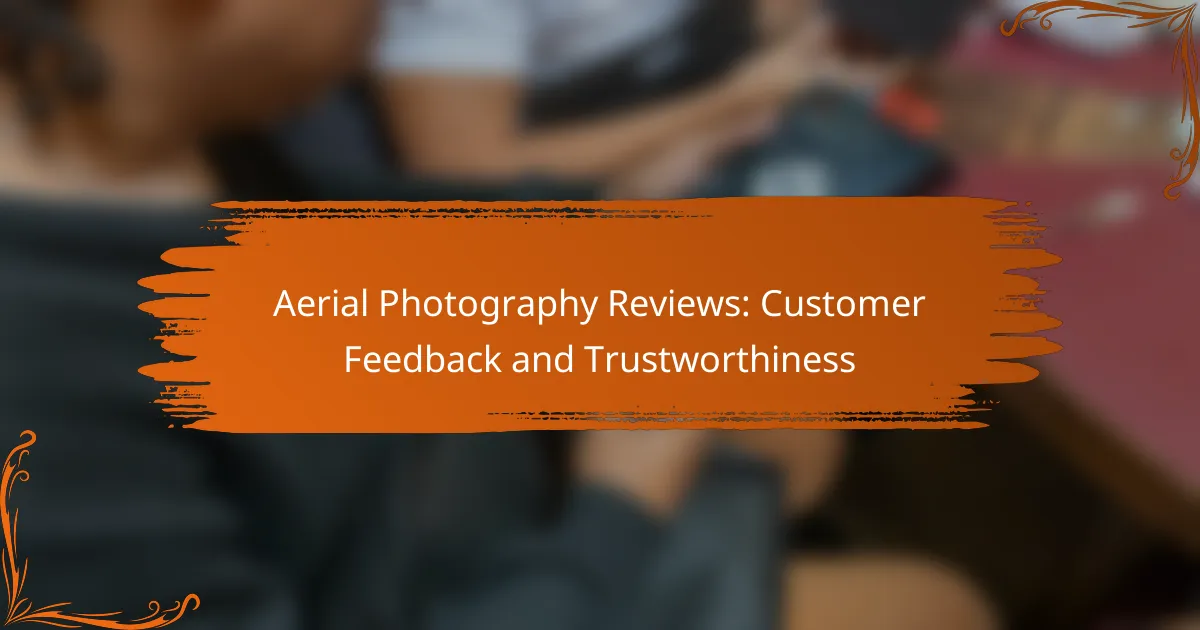Aerial photography is a dynamic field influenced by various factors such as weather, location, and event type, which can significantly impact the quality of the shoot. Selecting a reputable service involves evaluating their portfolio, client feedback, and technical expertise to ensure they can deliver the desired results. Additionally, different styles of aerial photography, including drone shots and 360-degree panoramas, provide unique perspectives that enhance event storytelling.

What factors influence aerial photography services in the UK?
Aerial photography services in the UK are influenced by several key factors, including weather conditions, event location, time of day, type of event, and regulatory restrictions. Understanding these elements can help ensure successful aerial shoots that meet client expectations.
Weather conditions
Weather plays a crucial role in aerial photography, as clear skies and minimal wind are ideal for capturing high-quality images. Overcast days can diffuse light, which may be beneficial for some shots but detrimental for others. Always check the forecast and consider rescheduling if conditions are unfavorable.
Common weather-related issues include rain, fog, and strong winds, which can hinder visibility and stability. It’s advisable to have backup plans in place, such as alternative dates or indoor locations, to avoid cancellations.
Event location
The location of the event significantly impacts aerial photography services, as some areas may have restrictions or unique features that affect the shoot. Urban settings often require special permissions due to airspace regulations, while rural locations may offer more flexibility.
Consider the landscape and surroundings when planning your shoot. Scenic backdrops can enhance the visual appeal of the photographs, while cluttered or uninteresting areas may detract from the overall quality.
Time of day
The time of day affects lighting conditions, which are critical for aerial photography. The golden hour, shortly after sunrise or before sunset, provides soft, warm light that can enhance the beauty of images. Midday sun, while bright, can create harsh shadows and overexposed areas.
Plan your aerial shoot around these optimal lighting conditions to achieve the best results. If shooting during less favorable times, consider using filters to manage glare and improve image quality.
Type of event
The type of event being photographed influences both the approach and the equipment used. Weddings, corporate events, and sports activities each have unique requirements and expectations. For instance, weddings may require more romantic and candid shots, while sports events focus on action and movement.
Tailor your aerial photography style to match the event’s nature. Discuss with clients their vision and any specific moments they want captured to ensure satisfaction with the final product.
Regulatory restrictions
In the UK, aerial photography is subject to strict regulatory restrictions, particularly regarding airspace and safety. Drone operators must adhere to the Civil Aviation Authority (CAA) regulations, which include maintaining a certain distance from people and structures and obtaining necessary permissions for commercial use.
Before conducting an aerial shoot, ensure you are familiar with local regulations and have the required licenses. This preparation will help avoid legal issues and ensure a smooth photography experience.
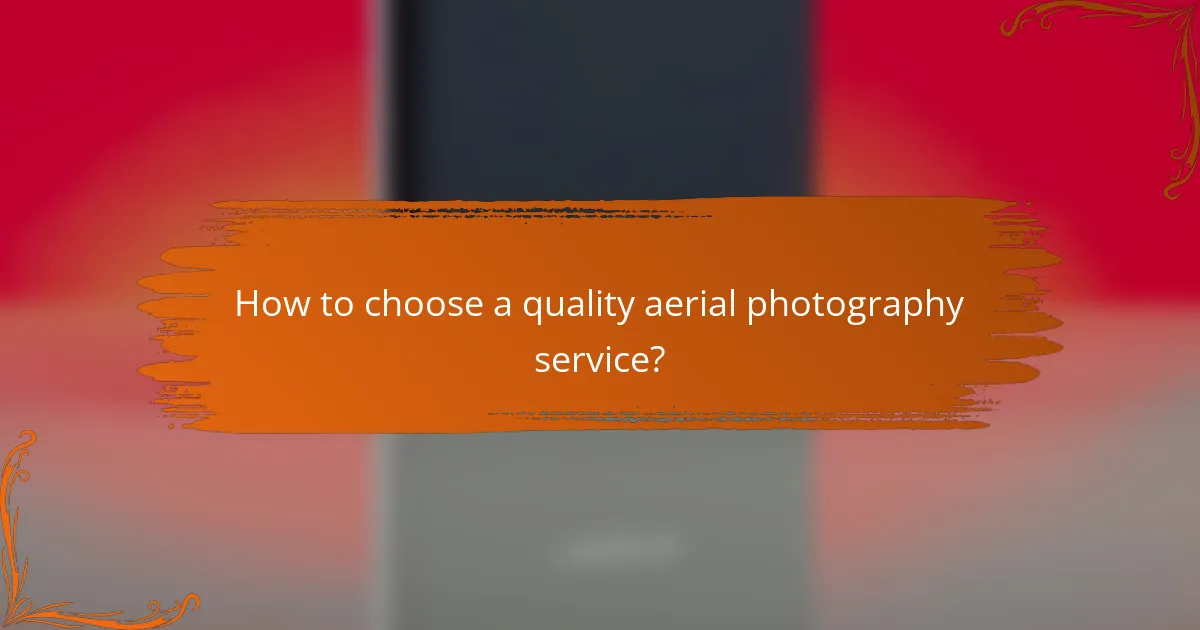
How to choose a quality aerial photography service?
To choose a quality aerial photography service, assess their portfolio, client testimonials, equipment, and experience. These factors will help you determine the service’s capability to meet your specific needs and expectations.
Portfolio review
A thorough portfolio review is essential when selecting an aerial photography service. Look for a diverse range of projects that showcase different styles, subjects, and settings. This will give you insight into the photographer’s versatility and creativity.
Pay attention to the quality of the images, including clarity, composition, and color balance. A strong portfolio should demonstrate not only technical skill but also an artistic vision that aligns with your preferences.
Client testimonials
Client testimonials provide valuable insights into the reliability and professionalism of an aerial photography service. Look for reviews that highlight the photographer’s communication skills, punctuality, and overall satisfaction with the final product.
Consider reaching out to past clients for direct feedback. This can help you gauge the service’s consistency and ability to meet deadlines, which is crucial for event-based photography.
Equipment used
The equipment used by an aerial photography service significantly impacts the quality of the images produced. Inquire about the type of drones and cameras they utilize, as well as any additional gear such as stabilizers or lenses.
High-quality drones typically offer better image resolution and stability. Ensure that the service uses up-to-date technology that complies with local regulations, which may dictate specific equipment standards.
Experience level
The experience level of the aerial photographer is a key factor in ensuring quality results. Look for services with a proven track record in aerial photography, particularly in the type of event you are planning.
Experienced photographers are more likely to anticipate challenges and adapt to changing conditions, which can be crucial during live events. Ask about their years of operation and the variety of projects they have completed to assess their expertise.

What styles of aerial photography are popular for events?
Popular styles of aerial photography for events include traditional aerial shots, drone photography, 360-degree panoramas, and video capture. Each style offers unique perspectives and can enhance the visual storytelling of an event.
Traditional aerial shots
Traditional aerial shots are typically captured using manned aircraft, providing a high vantage point over large areas. This style is ideal for events like festivals or marathons, where capturing the scale and layout is essential.
Consider the altitude and angle when planning traditional aerial shots, as these factors significantly influence the final image quality. Ensure compliance with local aviation regulations, which may dictate flight paths and altitude limits.
Drone photography
Drone photography has gained popularity due to its versatility and cost-effectiveness. Drones can easily maneuver around venues, capturing dynamic angles and close-ups that traditional methods may miss.
When using drones, be mindful of battery life and flight restrictions, especially in urban areas or near airports. Aerial shots from drones can be particularly striking for weddings or corporate events, showcasing both the venue and the guests.
360-degree panoramas
360-degree panoramas provide an immersive view of an event, allowing viewers to explore the scene interactively. This style is effective for venues with significant architectural features or expansive outdoor settings.
To create high-quality panoramas, use a tripod and a camera with a wide-angle lens or a dedicated 360-degree camera. Post-processing is essential to stitch images seamlessly, ensuring a smooth viewing experience.
Video capture
Video capture in aerial photography offers dynamic storytelling, allowing for movement and action to be conveyed. This style is particularly useful for events like sports competitions or parades, where capturing the flow and energy is crucial.
When planning aerial video shoots, consider the frame rate and resolution to ensure high-quality footage. Additionally, smooth gimbal stabilization is vital to avoid shaky footage, enhancing the overall viewing experience.

What are the pricing ranges for aerial photography services in the UK?
Aerial photography services in the UK typically range from around £150 to £1,500, depending on various factors such as the type of project, duration, and complexity. Understanding these pricing ranges can help you budget effectively for your aerial photography needs.
Hourly rates
Hourly rates for aerial photography in the UK generally fall between £100 and £300. Factors influencing these rates include the photographer’s experience, equipment quality, and the specific requirements of the shoot. For shorter projects, hourly pricing can be a cost-effective option.
Package deals
Many aerial photography services offer package deals that can provide better value for comprehensive projects. These packages often include a set number of hours, editing services, and additional features like high-resolution images or video footage. Prices for these packages can range from £500 to £1,200, depending on the inclusions and duration.
Additional costs
When budgeting for aerial photography, consider potential additional costs such as travel expenses, permits, and editing fees. Travel costs can vary widely based on the location of the shoot, while permits may be required for certain areas, especially if flying near restricted zones. Editing services can add £50 to £200 to the overall cost, depending on the complexity of the edits required.
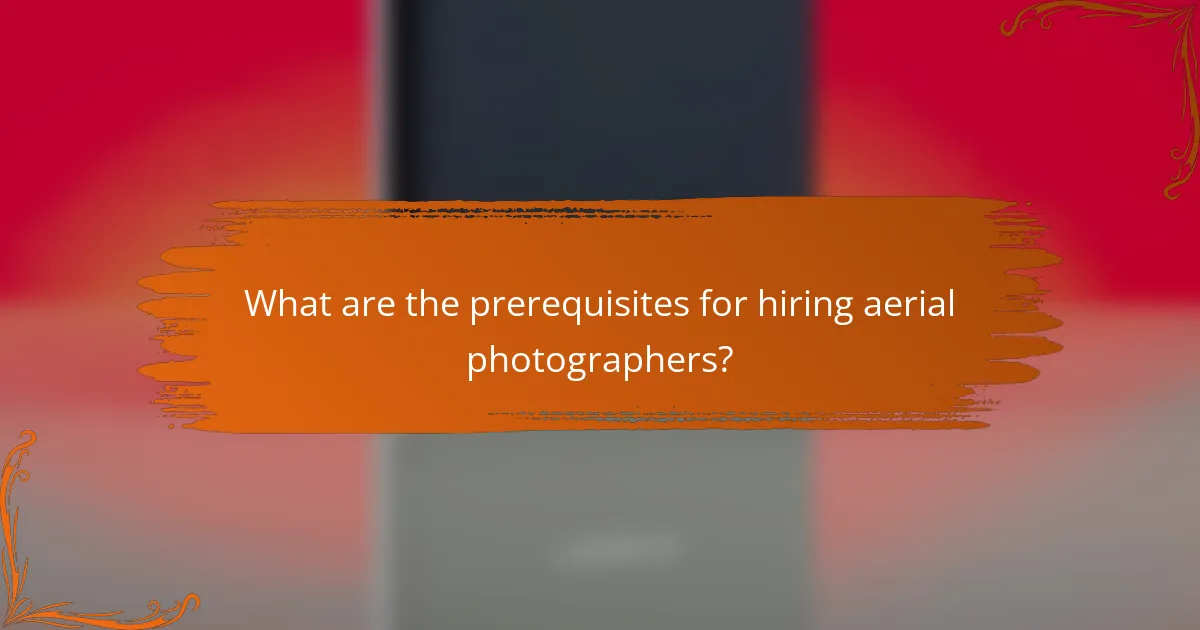
What are the prerequisites for hiring aerial photographers?
Before hiring aerial photographers, you should ensure they have the necessary licenses, equipment, and experience. It’s essential to verify their compliance with local regulations and their ability to meet your specific needs for the event.
Licensing and Regulations
Hiring aerial photographers requires understanding the licensing and regulations in your area. In the United States, for instance, photographers must have a Part 107 certification from the FAA to operate drones commercially. Similar regulations exist in other countries, so check local aviation authorities for specific requirements.
Ensure that the photographer is familiar with airspace restrictions and has the necessary permissions to operate in your desired location. This knowledge is crucial for avoiding legal issues and ensuring safety during the shoot.
Equipment Quality
The quality of the equipment used by aerial photographers significantly impacts the final images. Look for professionals who use high-resolution drones equipped with advanced cameras capable of capturing detailed images and videos. Popular models include the DJI Mavic series and the Phantom series.
In addition to the drone, consider the photographer’s backup equipment and safety gear. A reliable setup includes spare batteries, propellers, and a solid understanding of drone operation to handle unexpected situations.
Experience and Portfolio
Experience is a key factor when hiring aerial photographers. Review their portfolio to assess their style and the quality of their work. Look for examples that match the aesthetic you envision for your event, whether it’s a wedding, corporate gathering, or real estate project.
Ask for references or testimonials from previous clients to gauge their professionalism and reliability. Experienced photographers will also have a better understanding of how to capture the best angles and lighting for your specific event.

